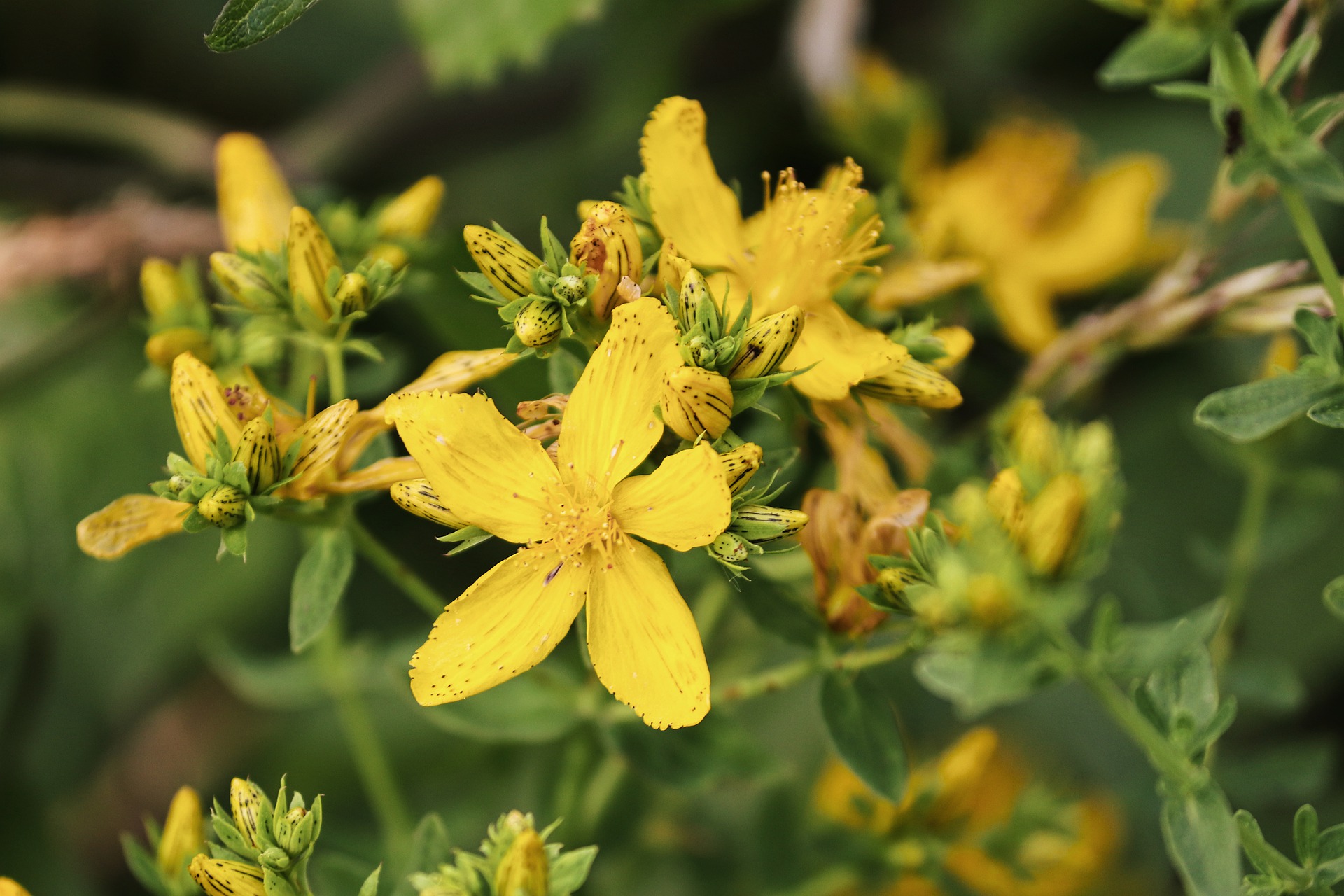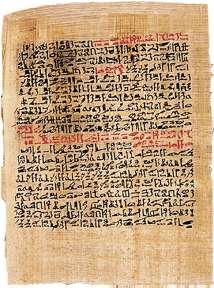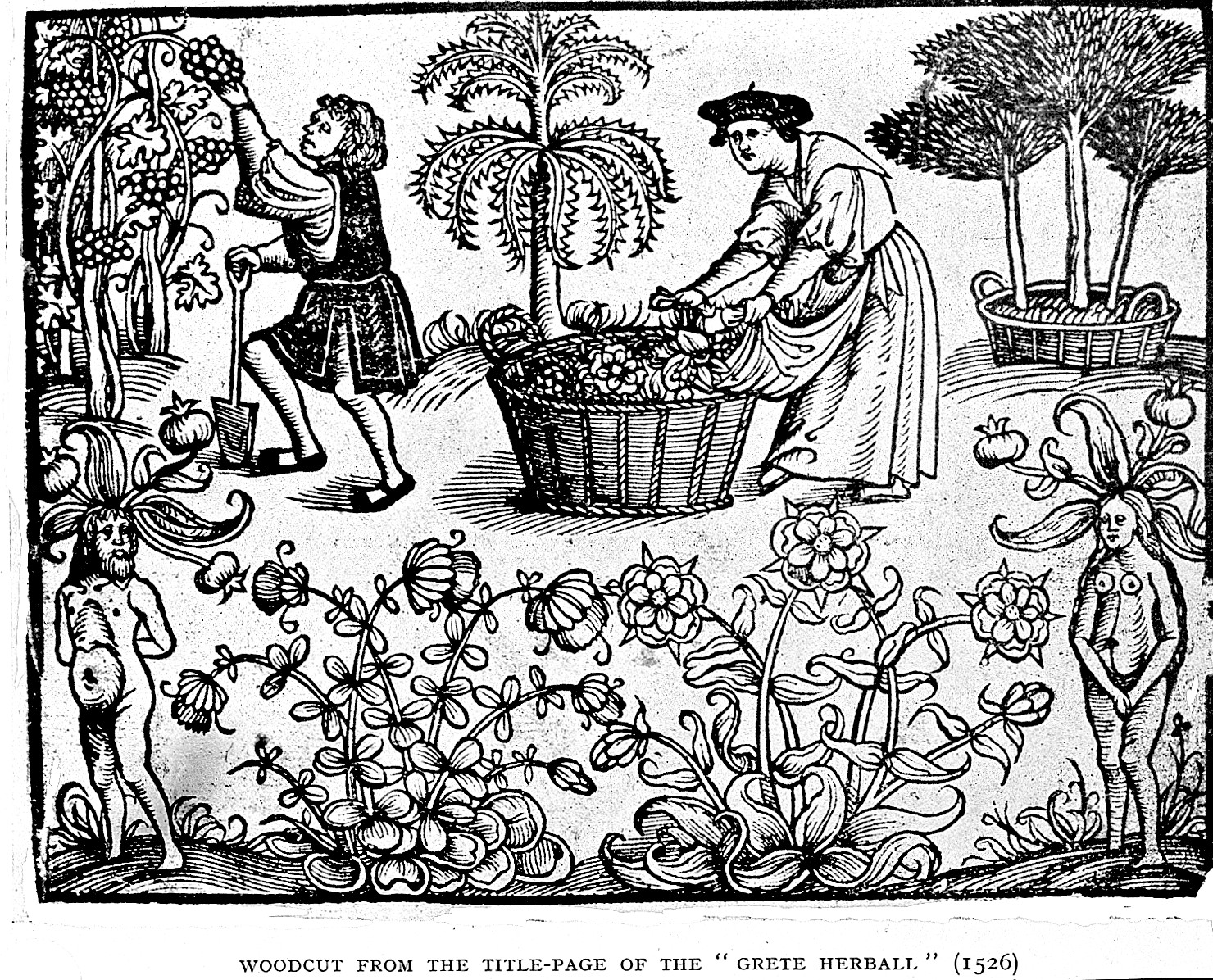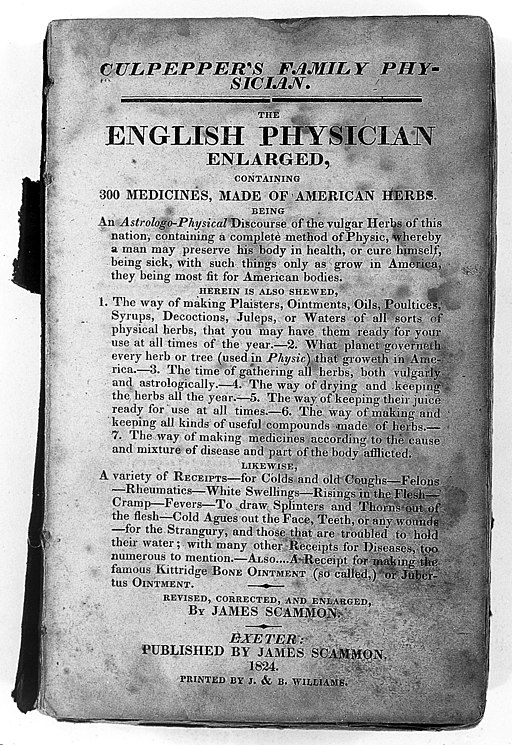HERBAL HISTORY: ROOTS OF WESTERN HERBALISM
Herbalism Through The Centuries
As independent organisms, the plants we use in herbalism have been around for a very, very long time—certainly much longer than us humans! While flowering plants have been around for some 125 million years, even the earliest proto-humans didn’t appear on the scene until about 5 million years ago. And plants, of course, have always featured as a keystone in the human diet—our paleolithic ancestors ate lots of plants (Richards, 2009), and seem to have used them medicinally, too.

There is archaeological evidence that paleolithic hominins ate both raw and cooked plants, and consumed “non-edible” herbs including willow, St. John’s wort, yarrow, chamomile, bupleurum, and more (Hardy, 2012; Melamed et al., 2016). This makes perfect sense! Imagine the life of a paleolithic human: your life literally depended on your immediate environment and a very keen sense of awareness. You and your fellow humans would have learned to recognize how different plants could be used for specific illnesses.
The First Written Records of Herbalism
When considering herbal history, it is important to remember that written records do not represent the full sum of knowledge or even the most valid knowledge, but they do give us a partial roadmap.
The first written record of medicinal plants was created on clay tablets over 5,000 years ago by the Sumerians, in ancient Mesopotamia, which described a dozen herbal recipes calling for the use of over 250 plants (Petrovska, 2012).

Ebers Papyrus
Around 1500 BCE the Ancient Egyptians wrote the Ebers Papyrus which listed over 850 herbal medicines. This wasn’t the first written document on herbalism and medical practice from the early Egyptians, but it survived intact and contains many different recipes and formulations including many herbs that we recognize and use today, such as cumin, coriander, garlic, willow, frankincense, cedar, aloe, and henna (Abou El-Soud, 2010).
Another early herbal tradition that we have written record of is Ayurveda, a system of medicine from India and surrounding areas. The oral tradition of Ayurveda is at least 5,000 years old (Mukherjee et al., 2016), and several important ayurvedic texts were written down starting at around 400 BCE. The Charaka Samhita, one of these ancient texts, mentions over 300 herbs (Reddy et al., 2007), many of which are still used in contemporary ayurvedic practice. Some, like ashwagandha, shatavari, bacopa, turmeric, and tulsi, have become common in Western herbal practice as well.
Legendary Chinese emperor Chi’en Nung is credited with writing the foundational materia medica of classical Chinese medicine, Pen Ts’ao Ching, which lists over 365 herbs. By some counts it is believed to record some traditional practices that may date back to as early as about 2700 BCE, almost 5,000 years ago, which were passed down through the oral tradition. The earliest version of the text we know today as the Pen Ts’ao Ching was compiled by Tao Hongjing and published around 500 CE (Dharmananda, 2004). Many herbs included in the Pen Ts’ao Ching are widely used in the practice of Chinese medicine today, and quite a few have made their way into the materia medica of Western herbalists, as well. Just a few of the well known and much loved herbs mentioned in this book include astragalus, licorice, reishi, ginger, schisandra, and dong quai.
Roots of the Western Herbal Tradition
When we read about the roots of both modern medicine and contemporary Western herbal practice, we often hear about Hippocrates and other Greek physicians of his era, around 400 BCE. In part that’s because Hippocrates and his fellow thinkers were some of the first to write down a system that separated medicine from religious practice; Hippocrates insisted that sickness originates in the physical body, rather than being caused by spiritual illness or punishment from gods. (This wasn’t a popular view at the time, and Hippocrates was even imprisoned for his views. He used his time well, though, and spent his time in prison writing The Complicated Body, which included many medical theories that are still applied today.)
At this time, and for many centuries to follow, there would not have been a distinct separation between the practice of medicine and the use of herbs—the primary remedies used were diet, plant and animal-derived medicines, and surgery. Medicine then, with the exception of surgery, was largely what today we would consider natural medicine.
While Hippocratic thought is notable for both its written record and its separation of physical and religious treatment of illness, it didn’t arise out of nowhere; Hippocrates, like other Greek physicians, drew on his forerunners in medicine, which almost certainly included knowledge and practice handed down from ancient Chinese, Indian, and Egyptian healing systems (Jackson, 2014).
Unfortunately, the history of medicine is often assumed to be equivalent to the history of medicine in Europe, and we may unconsciously make this mistake in framing herbalism, as well. But just as what we often call Western medicine truly has some very deep roots in traditional healing systems of Asia and Africa, so too does Western herbalism.
Tracing the history of Western herbalism is like following just one long thread in a tapestry, or one small stream as it merges, branches, and diverges—it certainly isn’t the one and only History of Herbalism! And even within what’s generally called Western herbalism, there are many individual threads and pathways; because the use of plants in healing is more or less intrinsic to human cultures, rich individual traditions of herbalism exist in every part of the globe. In the rest of this article we’ll focus on the lineage of Western herbalism, which centers geographically on Europe and, later, North America. But Western herbalism itself has drawn on and incorporated knowledge from all over the globe, including Islamic medicine, traditional healing from First Nations and other Indigenous Peoples, and more.
Medieval Herbalism
One of the earliest European universities was located in Salerno, in Southern Italy. In the 10th century, the Salerno school became a center of medical learning in medieval Europe. One of the keys to the Salerno renaissance was the translation of important Islamic medical texts from Arabic into Latin and French.
At the same time, monasteries throughout Europe also contributed to the development and documentation of herbal and medical practices, both by directly treating the sick and by fostering the translation and copying herbals and books of medical theory. In this era, prior to the development of moveable type and the printing press, the only way to replicate a text was by hand copying it, so written records of herbalism would have been relatively scarce and precious.
The Herbalism Boom

Title page Grete Herball, 1526, from Wellcome Library (https://commons.wikimedia.org/wiki/File:Grete_Herball,_1526_Wellcome_L0000809.jpg) [CC BY 4.0 (http://creativecommons.org/licenses/by/4.0/)]
Nicholas Culpeper (1616-1654) was an English herbalist, botanist, apothecary (what we’d now call a pharmacist), physician, and astrologer. He published a most extensive herbal on pharmaceuticals, herbal knowledge, and the practice of astrological medicine. Culpeper spent a great amount of time outdoors and cataloged hundreds of medicinal herbs. He was a passionate and practical advocate of accessible herbalism and medicine, offering free treatment consisting mostly of herbal remedies to anyone in need. Culpeper was committed to making medical information available to all by translating into and writing his own texts in English and distributing his books at very low cost. His dedication to sharing herbal and medical information put him at odds with the powerful College of Physicians, who fought staunchly to keep their monopoly on medical knowledge and prohibit English translations of medical texts; for his pains, Culpeper was twice tried for witchcraft and nearly barred from practice (Tobyn et al., 2011).
Western Herbalism in America

The English Physician from Wellcome Library (https://commons.wikimedia.org/wiki/File:The_English_Physician_._._.,_by_Nicholas_Culpeper_Wellcome_L0004047.jpg) [CC BY 4.0 (http://creativecommons.org/licenses/by/4.0/)]
American medical botanists learned about the native North American flora largely from the Indigenous Peoples who had worked with these plants for centuries. The legacy passed down from Western European herbalism combined with First Nations ethnobotany, the traditional healing knowledge of enslaved Africans, and herb lore from midwives and cottage herbalists to create a uniquely American herbal movement. It’s important to note that this was most often not a consensual collaboration; even when knowledge was shared freely, it occurred in the context of colonization, slavery, and other social forces that created a massive imbalance of power. Thus the “discoveries” published by celebrated physicians, botanists, and herbalists of the day may often have been based on appropriated and uncredited knowledge.
By the 19th century, the practice of medicine had veered away from the use of simple herbs and emphasized the use of “heroic medicines” including purging, bloodletting, and harsh, even toxic, minerals such as arsenic and mercury. Two groups of unconventional physicians, the Eclectics and the Physio-Medicalists, stood out against the prevailing wisdom of the day, instead focusing on the use of botanical remedies and innovative, less-invasive therapies.
These various factions were often at odds, competing for reputation, prominence, and patients, but managed to co-exist until the ascendance of the Council on Medical Education (CME) of the American Medical Association (AMA) in 1904. The AMA determined to standardize medical education and set very specific standards of operation that were not met by many medical teaching facilities. Schools that could not meet their standards were shut down, which particularly affected many schools that served women and African American students (Wright-Mendoza, 2019). Between 1910 and 1935, more than half of all American medical schools merged with large universities or closed. Homeopathy, naturopathy, chiropractic, osteopathic medicine, and Eclectic medicine were in strong competition to allopathic medicine. Schools offering training in any of these disciplines were forced to drop these courses from their curricula or lose their accreditation.

Western Herbalism Today
While herbalism may have separated from conventional medicine, it certainly never went away. As folk medicine, traditional healing, or alternative care, many different types of herbal practice have continued to thrive.
Herbalism began a resurgence in America in the 1960s and 1970s, and its acceptance and popularity has slowly gained momentum in the last decades. The use of herbs has now begun to enter conventional medicine as part of the integrative or functional medicine movement, and herbs are often used by licensed practitioners of osteopathic or naturopathic medicine. And, of course, herbs are available all around us, not only on grocery store and apothecary shelves but in our gardens and backyards!
There is also an abundance of books, classes, conferences, and schools available to budding herbalists.
The Herbal Academy is one of those very schools offering high quality, affordable herbal education online with the hope of bringing an herbal education to as many people as possible and helping passionate folks follow their dreams of becoming an herbalist. Please visit our course page to learn about all of our offerings: https://theherbalacademy.com/courses-classes/
Also available is The Herbarium, https://herbarium.theherbalacademy.com, a virtual resource providing high-quality research and reference materials to both herbalists and students. Additionally, there are free articles on many topics on the Herbal Academy blog: https://theherbalacademy.com/blog/.
REFERENCES
Abou El-Soud, N.H. (2010). Herbal medicine in ancient Egypt. Journal of Medicinal Plants Research, 4(2), 082-086.
Dharmananda, S. (2004). The lessons of Shennong. Retrieved from http://www.itmonline.org/arts/shennong.htm
Hardy, K., Buckley, S., Collins, M.J., Estalrrich, A., Brothwell, D., Copeland, L., … Huguet, R. (2012). Neanderthal medics? Evidence for food, cooking, and medicinal plants entrapped in dental calculus. Naturwissenschaften, 99(8), 617-626. https://doi.org/10.1007/s00114-012-0
Jackson, M. (2014). The history of medicine: A beginner’s guide. London, UK: OneWorld Publications.
Melamed, Y., Kislev, M.E., Geffen, E., Lev-Yadun, S., & Goren-Inbar, N. (2016). The plant component of an Acheulian diet at Gesher Benot Ya ‘aqov, Israel. Proceedings of the National Academy of Sciences, 113(51), 14674-14679. https://doi.org/10.1073/pnas.1607872113
Mukherjee, P.K., Harwansh, R.K., Bahadur, S., Banerjee, S., Kar, A., Chanda, J., … Katiyar, C.K. (2016). Development of Ayurveda: Tradition to trend. Journal of Ethnopharmacology, 197, 10-24. http://doi.org/10.1016/j.jep.2016.09.024
Petrovska, B. (2012). Historical review of medicinal plants’ usage. Pharmacognosy Reviews, 6(11), 1-5. http://doi.org/10.4103/0973-7847.95849
Reddy, J.K., Bahadur, B., Bhadraiah, B., & Rao, M.L.N. (2007). Advances in medicinal plants. Hyderabad, India: Universities Press.
Richards, M.P. (2009). Stable isotope evidence for European Upper Paleolithic human diets. In: Hublin J.J., Richards M.P. (Eds.) The Evolution of Hominin Diets. Vertebrate Paleobiology and Paleoanthropology. Springer, Dordrecht. https://doi.org/10.1007/978-1-4020-9699-0_20
Tobyn, G., Denham, A., & Whitelegg, M. (2016). The Western herbal tradition: 2000 years of medicinal plant knowledge. London, UK: Singing Dragon.
Wright-Mendoza, J. (2019). The 1910 report that disadvantaged minority doctors. JStor Daily. Retrieved from https://daily.jstor.org/the-1910-report-that-unintentionally-disadvantaged-minority-doctors/

